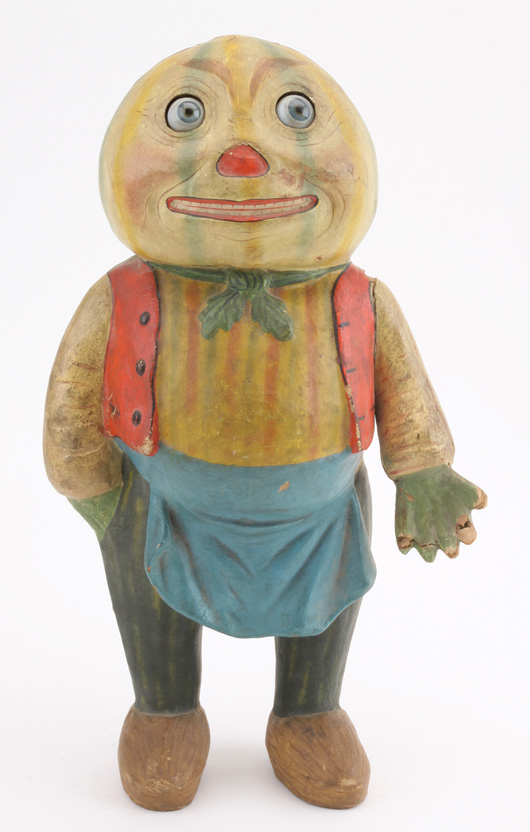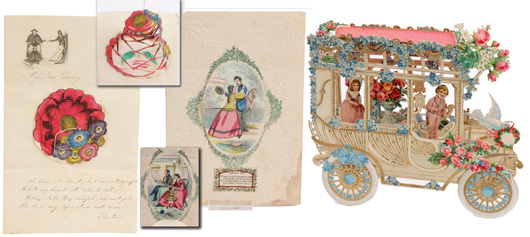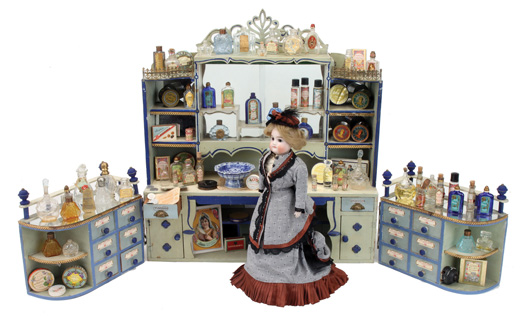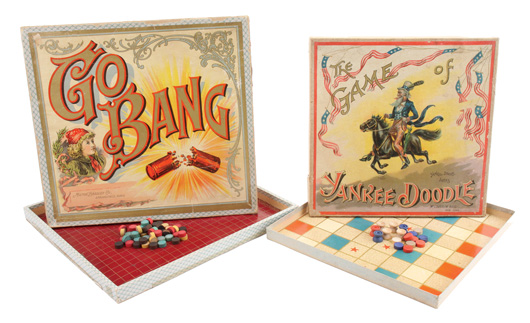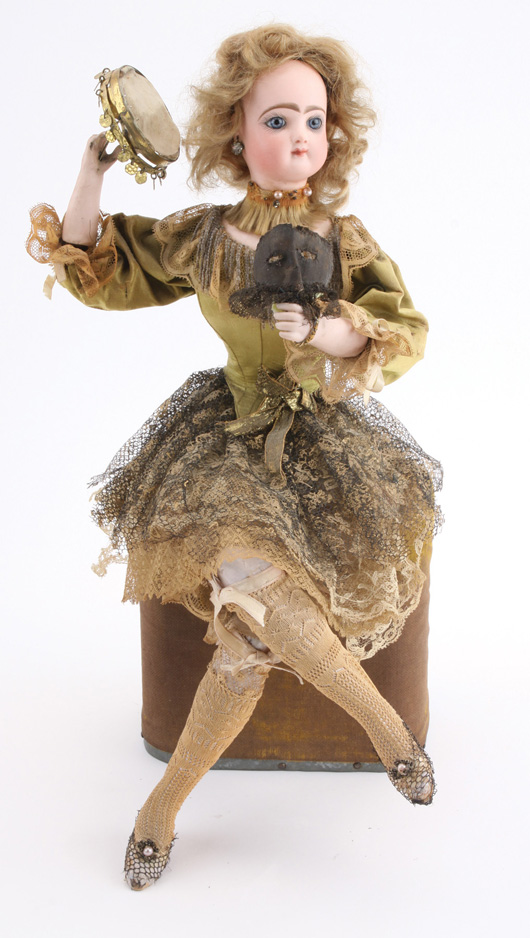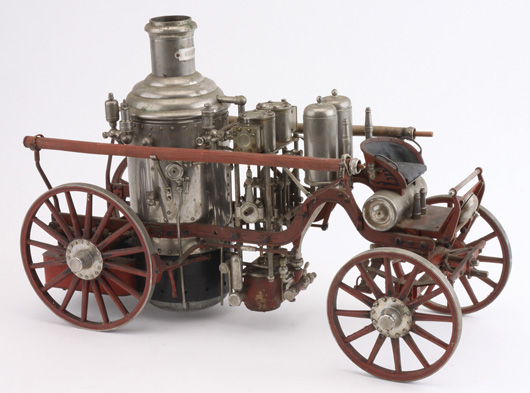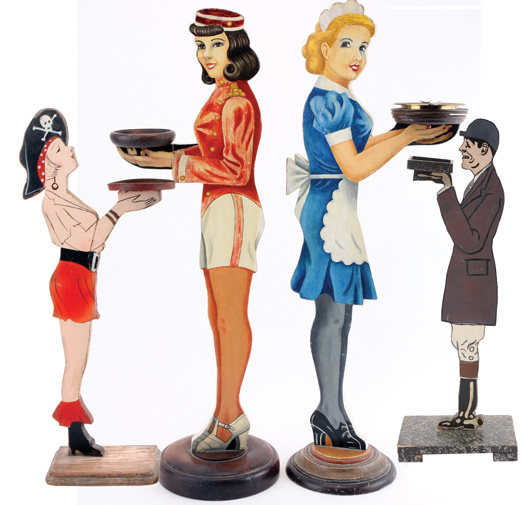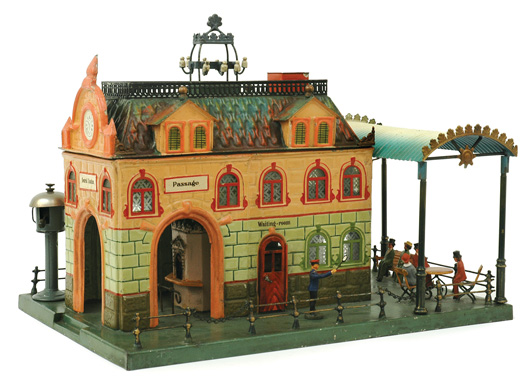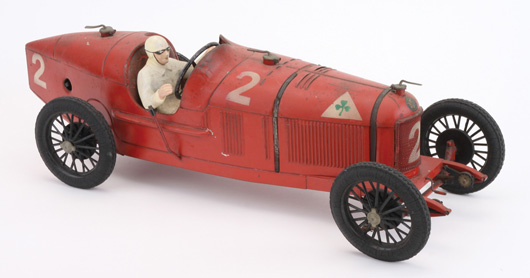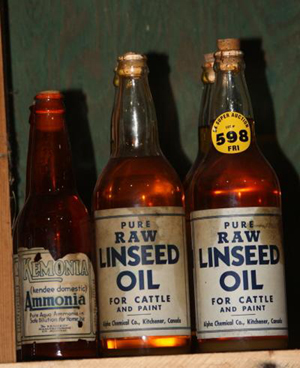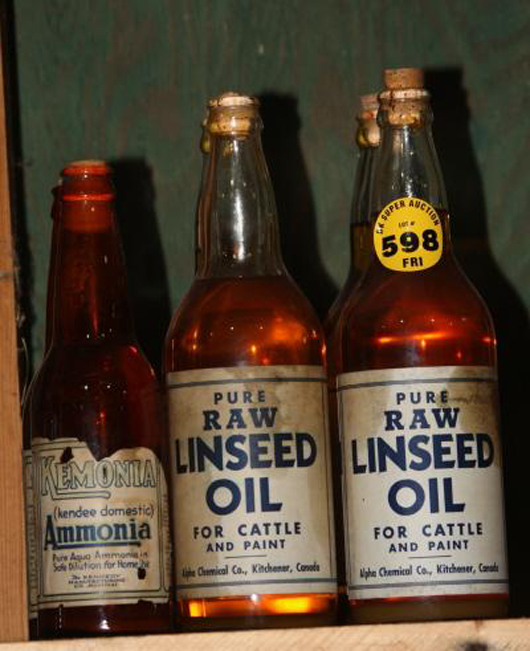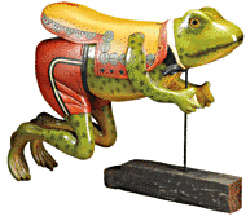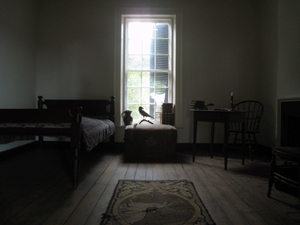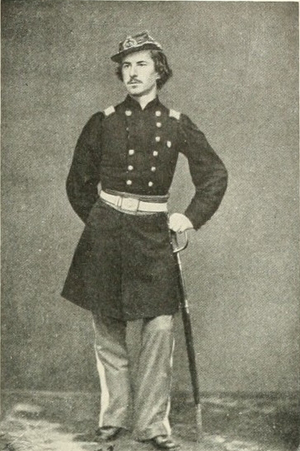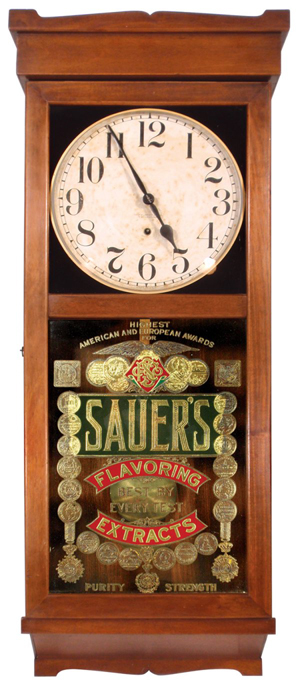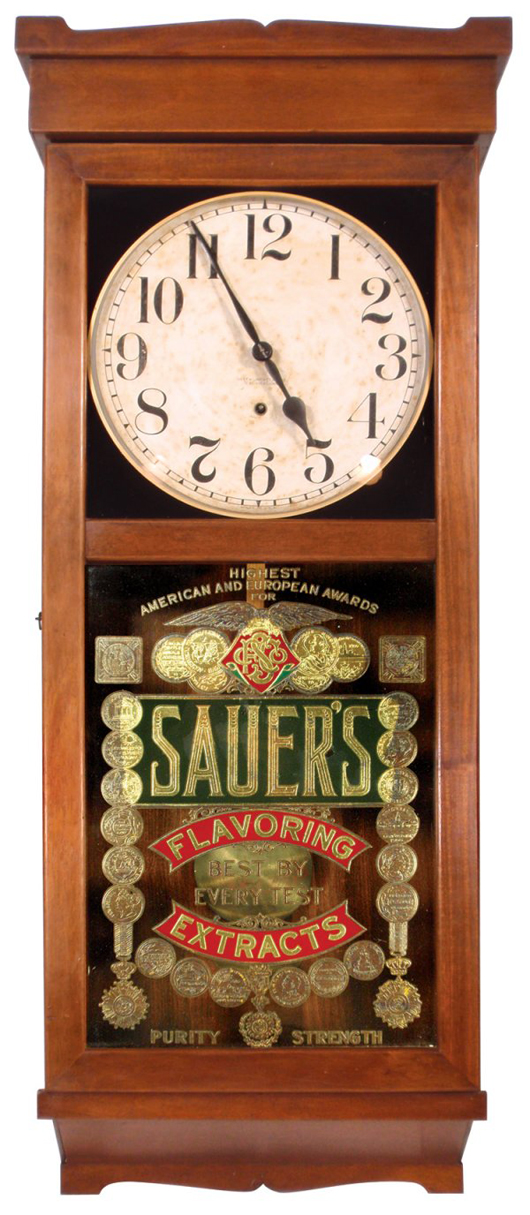
NEW HOPE, Pa. – As its title promises, Noel Barrett’s May 21 auction has “something for everyone” within its 714-lots, from fresh-to-market holiday items and antique games to coveted clockwork toys and salesmen’s samples. The Saturday event commencing at 10 a.m. at the Eagle Fire Hall in New Hope, Pa., will feature items from the collections of Philip and Ann Henderson, and Rex Horchem.
The eclectic array of treasures opens with a small selection of Christmas Dresdens and diecuts; Thanksgiving candy containers and decorations; and an extremely rare clockwork Halloween veggie man with moving eyes.
Auction company owner Noel Barrett commented that the early 20th-century papier-mache veggie man, which stands an impressive 16 inches tall, was quite likely used as a store window display piece, a k a sales stimulator. “This is only the second such vegetable man to have surfaced in recent memory,” said Barrett. “The other example had significant repair, including the fabrication of the missing left hand. This example has the complete, fully fingered hand, which needs only minor restoration.” The whimsically wide-eyed mechanical veggie man is estimated at $10,000-$15,000.
A colorful grouping of valentines to be offered at the auction runs the gamut of materials and styles, with a timeline from the late 18th century to the 1940s. There are early woodcuts, fold-downs with “honeycombs,” celluloids, lace-edged greetings, and dimensional cars, ships and architectural structures, among many other types. The 90-lot offering also includes some highly desirable crossovers, such as the circa-1861 Civil War valentine of heavy embossed paper with a hand-colored engraving of a soldier returning home to his wife and child. It is estimated at $250-$350. An additional ephemera highlight is a 1904 “Our Sailor Boy” mechanical calendar depicting a youngster in naval attire, with British and American flags in the background and a cannon in the foreground. The “smoke” emitted from the cannon is embossed with calendar pages from all 12 months and is retractable to fit back into the cannon. Estimate: $100-$200.
A broad mix of early games and puzzles – both German and American made – will keep bidders amused as they work their way through the many themes that were popular at the turn of the 20th century, such as transportation, military, sports and animals. An unusual entry that reflects how safety standards in toys have changed is the 1924 Zulu Blowing Game consisting of blow darts, targets and an instructions sheet extolling the game’s health benefits. “Develop the Children’s Lungs,” the paperwork encourages. Estimate: $300-$400.
Some very nice dollhouses, room boxes and shops will be auctioned, including two Gottschalk productions: an apothecary and grocery store; two German stables with figures, a confectionary shop and a kitchen plentifully outfitted with metal utensils, vessels, plates and other miniatures. Worth of special note is a Parisian perfumery stocked with various fragrances in glass bottles, as well as powders, soaps and pomades, all arranged on mirror-topped counters and on vanity shelves. The deluxe tableau is accompanied by a well-dressed bisque-head doll and is expected to make $2,000-$3,000.
Paper-litho on wood toys include seven boats by Reed and Bliss; two European toy theaters and four castle fortresses. A collection of Brownie toys comes from a consignor whose uncle originally amassed the items over a long period of time. A sales receipt found with the collection revealed that a set of antique McLoughlin Brownie Nine Pins had been purchased in 1954 for $17. At Barrett’s sale, the set is more likely to sell for $2,000-$3,000.
An exceptional 19th-century Lambert bisque-head “Bal Masque” dancer automaton is dressed in a lace-covered dress and stockings, and sits atop a fabric box that encases a 2-tune music box. When activated, the dancer kicks her crossed leg forward, lifts her black mask with one hand and shakes a tambourine with her other hand. In excellent, all-original condition, the automaton carries a $4,000-$6,000 estimate.
Another example of fine French artistry, a 24-inch-long articulated pull toy consisting of a team of four dappled composition horses and a bisque-head lady rider served as the inspiration for a painting by Jacques Millet. The actual 1976 painting of the antique toy is included in the lot, which is estimated at $4,000-$6,000.
The Americana and folk art section offers a charming Victorian child’s sleigh, salesmen’s samples and several rocking horses, including one that was crafted around a beautiful circa-1900 German carrousel horse. The elegant nursery steed is pictured in Patricia Mullins’s book The Rocking Horse, a copy of which is included in the lot estimated at $4,000-$6,000.
The folk-art lineup continues with a featured collection of more than 60 smoking stands to be apportioned into 34 lots. The varied figural shapes replicate butlers, maids, bellhops, black cats, an Indian chief, and comic characters such as Popeye, Mickey Mouse and Jiggs & Maggie.
Another handmade item that’s expected to set off alarm bells is a Seagrave Co. salesmen’s sample fire ladder wagon. “The quality of construction and accuracy of detail in this piece is a sight to behold,” said Barrett. “It is outfitted with an array of ladders, fire axes, extinguishers, lanterns, fire buckets and more. It’s one of the most amazing salemen’s samples we have seen.” Measuring 50 inches long, the piece had resided in a Bucks County, Pa., house, its whereabouts well known to Barrett for 15 years prior to its consignment. It is estimated at $7,000-$10,000. Also vying for the spotlight is a highly detailed, spirit-fired 21-inch-long, 32 lb. fire pumper model that appears to have all the necessary mechanical components required to be fully functional. A masterful creation, it is expected to fetch $6,000-$7,000.
Serious collectors of antique advertising would know the self-framed Marathon Tires sign depicting two couples in a red open tourer, navigating a narrow, craggy ledge. Printed by the famed tin sign maker Kaufmann & Strauss, it measures 22¾ inches by 19¾ inches. Estimate: $8,000-$10,000.
Barrett remarked that there has been “a lot of excitement and interest” over a promotional model of a Junkers F.13 promotional airplane model. “The real-life 1919 plane that inspired the model was the first all-metal transport plane. When I took the piece, I didn’t realize it was a promotional piece made for Junkers. Some German collectors who came to gallery were able to identify what it was.”
Several lots of highly desirable American painted-tin toys are consigned to the May 21 auction. Two of the best were attic finds. Discovered in California, a Fallows 1886 (patented) Buffalo Hunter on wheeled base is estimated at $2,000-$3,000. As the toy is pulled along, a design feature enables the pair of buffalo to rock back and forth, as though running. The top toy in the group is a George Brown horse-drawn omnibus stenciled “Broadway & Central Park.” In a white with maroon color scheme and fresh from a Long Island home, the toy will make its auction debut with an $8,000-$12,000 estimate.
The last of the toys from the celebrated Ward Kimball collection will be auctioned. A Hull & Stafford “America” clockwork tin and wood locomotive is estimated at $3,000-$4,000; while a George Brown “Niagara” clockwork locomotive, also of tin and wood, could earn $800-$1,000.
Certain to finish near the top of prices realized, a Marklin Central-Bahnhof train station #2651 is hand painted and has a fully outfitted, candlelit interior that includes a table, chairs and benches. Its details are superb: etched and stained-glass windows, doorway arches, canopy and ticket-queue rail. “An advanced collector who looked at this station said it is the best example he has ever seen,” Barrett commented. Its estimate is $10,000-$15,000. An American-profile Carette gauge 1 #2350 steam loco and tender may roll across the auction block in the $12,000-$15,000 range.
For information on any lot in the sale, call 215-297-5109 or e-mail toys@noelbarrett.com.
View the fully illustrated catalog and sign up to bid absentee or live via the Internet at www.LiveAuctioneers.com.
# # #
ADDITIONAL LOTS OF NOTE
